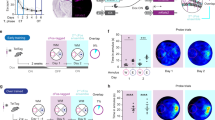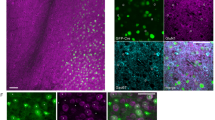Abstract
Hippocampal NMDA receptors (NMDARs) and NMDAR-dependent synaptic plasticity are widely considered crucial substrates of long-term spatial memory, although their precise role remains uncertain. Here we show that Grin1ΔDGCA1 mice, lacking GluN1 and hence NMDARs in all dentate gyrus and dorsal CA1 principal cells, acquired the spatial reference memory water maze task as well as controls, despite impairments on the spatial reference memory radial maze task. When we ran a spatial discrimination water maze task using two visually identical beacons, Grin1ΔDGCA1 mice were impaired at using spatial information to inhibit selecting the decoy beacon, despite knowing the platform's actual spatial location. This failure could suffice to impair radial maze performance despite spatial memory itself being normal. Thus, these hippocampal NMDARs are not essential for encoding or storing long-term, associative spatial memories. Instead, we demonstrate an important function of the hippocampus in using spatial knowledge to select between alternative responses that arise from competing or overlapping memories.
This is a preview of subscription content, access via your institution
Access options
Subscribe to this journal
Receive 12 print issues and online access
$209.00 per year
only $17.42 per issue
Buy this article
- Purchase on Springer Link
- Instant access to full article PDF
Prices may be subject to local taxes which are calculated during checkout







Similar content being viewed by others
References
Bliss, T.V. & Collingridge, G.L. A synaptic model of memory: long-term potentiation in the hippocampus. Nature 361, 31–39 (1993).
Martin, S.J., Grimwood, P.D. & Morris, R.G. Synaptic plasticity and memory: an evaluation of the hypothesis. Annu. Rev. Neurosci. 23, 649–711 (2000).
Neves, G., Cooke, S.F. & Bliss, T.V. Synaptic plasticity, memory and the hippocampus: a neural network approach to causality. Nat. Rev. Neurosci. 9, 65–75 (2008).
Morris, R.G., Anderson, E., Lynch, G.S. & Baudry, M. Selective impairment of learning and blockade of long-term potentiation by an N-methyl-d-aspartate receptor antagonist, AP5. Nature 319, 774–776 (1986).
Bannerman, D.M., Good, M.A., Butcher, S.P., Ramsay, M. & Morris, R.G. Distinct components of spatial learning revealed by prior training and NMDA receptor blockade. Nature 378, 182–186 (1995).
Saucier, D. & Cain, D.P. Spatial learning without NMDA receptor-dependent long-term potentiation. Nature 378, 186–189 (1995).
Tsien, J.Z., Huerta, P.T. & Tonegawa, S. The essential role of hippocampal CA1 NMDA receptor-dependent synaptic plasticity in spatial memory. Cell 87, 1327–1338 (1996).
Tsien, J.Z. et al. Subregion- and cell type-restricted gene knockout in mouse brain. Cell 87, 1317–1326 (1996).
Wiltgen, B.J. et al. A role for calcium-permeable AMPA receptors in synaptic plasticity and learning. PLoS ONE 5, e12818 (2010).
Hoeffer, C.A. et al. Removal of FKBP12 enhances mTOR-Raptor interactions, LTP, memory, and perseverative/repetitive behavior. Neuron 60, 832–845 (2008).
Fukaya, M., Kato, A., Lovett, C., Tonegawa, S. & Watanabe, M. Retention of NMDA receptor NR2 subunits in the lumen of endoplasmic reticulum in targeted NR1 knockout mice. Proc. Natl. Acad. Sci. USA 100, 4855–4860 (2003).
Brigman, J.L. et al. Loss of GluN2B-containing NMDA receptors in CA1 hippocampus and cortex impairs long-term depression, reduces dendritic spine density, and disrupts learning. J. Neurosci. 30, 4590–4600 (2010).
Rondi-Reig, L. et al. Impaired sequential egocentric and allocentric memories in forebrain-specific-NMDA receptor knock-out mice during a new task dissociating strategies of navigation. J. Neurosci. 26, 4071–4081 (2006).
Niewoehner, B. et al. Impaired spatial working memory but spared spatial reference memory following functional loss of NMDA receptors in the dentate gyrus. Eur. J. Neurosci. 25, 837–846 (2007).
McHugh, T.J. et al. Dentate gyrus NMDA receptors mediate rapid pattern separation in the hippocampal network. Science 317, 94–99 (2007).
Murray, A.J. et al. Parvalbumin-positive CA1 interneurons are required for spatial working but not for reference memory. Nat. Neurosci. 14, 297–299 (2011).
Dillon, G.M., Qu, X., Marcus, J.N. & Dodart, J.C. Excitotoxic lesions restricted to the dorsal CA1 field of the hippocampus impair spatial memory and extinction learning in C57BL/6 mice. Neurobiol. Learn. Mem. 90, 426–433 (2008).
Logue, S.F., Paylor, R. & Wehner, J.M. Hippocampal lesions cause learning deficits in inbred mice in the Morris water maze and conditioned-fear task. Behav. Neurosci. 111, 104–113 (1997).
Bannerman, D.M. et al. Double dissociation of function within the hippocampus: a comparison of dorsal, ventral, and complete hippocampal cytotoxic lesions. Behav. Neurosci. 113, 1170–1188 (1999).
Moser, M.B., Moser, E.I., Forrest, E., Andersen, P. & Morris, R.G. Spatial learning with a minislab in the dorsal hippocampus. Proc. Natl. Acad. Sci. USA 92, 9697–9701 (1995).
Pothuizen, H.H., Zhang, W.N., Jongen-Relo, A.L., Feldon, J. & Yee, B.K. Dissociation of function between the dorsal and the ventral hippocampus in spatial learning abilities of the rat: a within-subject, within-task comparison of reference and working spatial memory. Eur. J. Neurosci. 19, 705–712 (2004).
von Engelhardt, J. et al. Contribution of hippocampal and extra-hippocampal NR2B-containing NMDA receptors to performance on spatial learning tasks. Neuron 60, 846–860 (2008).
Shimshek, D.R. et al. Enhanced odor discrimination and impaired olfactory memory by spatially controlled switch of AMPA receptors. PLoS Biol. 3, e354 (2005).
Suchanek, B., Seeburg, P.H. & Sprengel, R. Tissue specific control regions of the N-methyl-D-aspartate receptor subunit NR2C promoter. Biol. Chem. 378, 929–934 (1997).
Tashiro, A., Sandler, V.M., Toni, N., Zhao, C. & Gage, F.H. NMDA-receptor-mediated, cell-specific integration of new neurons in adult dentate gyrus. Nature 442, 929–933 (2006).
Lyon, L. et al. Fractionation of spatial memory in GRM2/3 (mGlu2/mGlu3) double knockout mice reveals a role for group II metabotropic glutamate receptors at the interface between arousal and cognition. Neuropsychopharmacology 36, 2616–2628 (2011).
Morris, R.G., Hagan, J.J. & Rawlins, J.N. Allocentric spatial learning by hippocampectomised rats: a further test of the “spatial mapping” and “working memory” theories of hippocampal function. Q. J. Exp. Psychol. B 38, 365–395 (1986).
Uekita, T. & Okaichi, H. Pretraining does not ameliorate spatial learning deficits induced by intrahippocampal infusion of AP5. Behav. Neurosci. 123, 520–526 (2009).
Brun, V.H. et al. Place cells and place recognition maintained by direct entorhinal-hippocampal circuitry. Science 296, 2243–2246 (2002).
Steffenach, H.A., Witter, M., Moser, M.B. & Moser, E.I. Spatial memory in the rat requires the dorsolateral band of the entorhinal cortex. Neuron 45, 301–313 (2005).
Morris, R.G., Schenk, F., Tweedie, F. & Jarrard, L.E. Ibotenate lesions of hippocampus and/or subiculum: dissociating components of allocentric spatial learning. Eur. J. Neurosci. 2, 1016–1028 (1990).
Morris, R.G., Davis, S. & Butcher, S.P. Hippocampal synaptic plasticity and NMDA receptors: a role in information storage? Phil. Trans. R. Soc. Lond. B 329, 187–204 (1990).
Vinogradova, O.S. Functional organization of the limbic system in the process of registration of information: facts and hypotheses. in The Hippocampus vol. 2 (eds. Isaacson, R.I. & Pribram, K.H.) 3–69 (Plenum, New York, 1975).
Gray, J.A. & McNaughton, N. The Neuropsychology of Anxiety (Oxford Univ. Press, Oxford, 2000).
Ploghaus, A. et al. Learning about pain: the neural substrate of the prediction error for aversive events. Proc. Natl. Acad. Sci. USA 97, 9281–9286 (2000).
Kumaran, D. & Maguire, E.A. Match mismatch processes underlie human hippocampal responses to associative novelty. J. Neurosci. 27, 8517–8524 (2007).
Kumaran, D. & Maguire, E.A. An unexpected sequence of events: mismatch detection in the human hippocampus. PLoS Biol. 4, e424 (2006).
O'Keefe, J. & Nadel, L. The Hippocampus as a Cognitive Map (Clarendon, Oxford, 1978).
O'Keefe, J. Place units in the hippocampus of the freely moving rat. Exp. Neurol. 51, 78–109 (1976).
Fyhn, M., Molden, S., Hollup, S., Moser, M.B. & Moser, E. Hippocampal neurons responding to first-time dislocation of a target object. Neuron 35, 555–566 (2002).
Honey, R.C., Watt, A. & Good, M. Hippocampal lesions disrupt an associative mismatch process. J. Neurosci. 18, 2226–2230 (1998).
Hollerman, J.R. & Schultz, W. Dopamine neurons report an error in the temporal prediction of reward during learning. Nat. Neurosci. 1, 304–309 (1998).
Marr, D. Simple memory: a theory for archicortex. Phil. Trans. R. Soc. Lond. B 262, 23–81 (1971).
Rolls, E.T. & Treves, A. Neural Networks and Brain Function (Oxford Univ. Press, Oxford, 1998).
Sahay, A., Wilson, D.A. & Hen, R. Pattern separation: a common function for new neurons in hippocampus and olfactory bulb. Neuron 70, 582–588 (2011).
Lee, G. & Saito, I. Role of nucleotide sequences of loxP spacer region in Cre-mediated recombination. Gene 216, 55–65 (1998).
Soriano, P. Generalized lacZ expression with the ROSA26 Cre reporter strain. Nat. Genet. 21, 70–71 (1999).
Tang, W. et al. Faithful expression of multiple proteins via 2A-peptide self-processing: a versatile and reliable method for manipulating brain circuits. J. Neurosci. 29, 8621–8629 (2009).
Jerecic, J. et al. Impaired NMDA receptor function in mouse olfactory bulb neurons by tetracycline-sensitive NR1 (N598R) expression. Brain Res. Mol. Brain Res. 94, 96–104 (2001).
Krestel, H.E., Mayford, M., Seeburg, P.H. & Sprengel, R. A GFP-equipped bidirectional expression module well suited for monitoring tetracycline-regulated gene expression in mouse. Nucleic Acids Res. 29, E39 (2001).
Jensen, V. et al. A juvenile form of postsynaptic hippocampal long-term potentiation in mice deficient for the AMPA receptor subunit GluR-A. J. Physiol. (Lond.) 553, 843–856 (2003).
Deacon, R.M., Bannerman, D.M., Kirby, B.P., Croucher, A. & Rawlins, J.N. Effects of cytotoxic hippocampal lesions in mice on a cognitive test battery. Behav. Brain Res. 133, 57–68 (2002).
Reisel, D. et al. Spatial memory dissociations in mice lacking GluR1. Nat. Neurosci. 5, 868–873 (2002).
Schmitt, W.B., Deacon, R.M., Seeburg, P.H., Rawlins, J.N. & Bannerman, D.M. A within-subjects, within-task demonstration of intact spatial reference memory and impaired spatial working memory in glutamate receptor-A-deficient mice. J. Neurosci. 23, 3953–3959 (2003).
Acknowledgements
We thank U. Amtmann, H. Monyer and I. Bertocchi for in situ hybridization, and W. Tang and D. Arcos Diaz for recombinant adeno-associated virus injections. We thank R. Deacon for assistance with lesion surgeries. This work was supported by a grant from the European Commission to the EUSynapse project (LSHM-CT-2005-019055) to P.H.S., Wellcome Trust Senior Research Fellowships 074385 and 087736 to D.M.B., a grant from the German Research Foundation (SFB636/A4; BMFT:NGFN/SP10, DFG-GA 427/8-1) to R.S. and a grant from the Bauer-Stiftung to T.B. Ø.H. and V.J. were supported by the Letten Foundation.
Author information
Authors and Affiliations
Contributions
R.S. and P.H.S. delineated the genetic concept. T.B., I.S. and R.S. generated and molecularly analyzed the Grin1ΔDGCA1 mice. Ø.H. and V.J. performed the electrophysiological analysis. D.M.B. designed the behavioral experiments. D.M.B., D.J.S. and A.T. performed behavioral analyses. D.M.B., T.B., R.S., J.N.P.R. and P.H.S. wrote the manuscript.
Corresponding authors
Ethics declarations
Competing interests
The authors declare no competing financial interests.
Supplementary information
Supplementary Text and Figures
Supplementary Figures 1–10 (PDF 15765 kb)
Rights and permissions
About this article
Cite this article
Bannerman, D., Bus, T., Taylor, A. et al. Dissecting spatial knowledge from spatial choice by hippocampal NMDA receptor deletion. Nat Neurosci 15, 1153–1159 (2012). https://doi.org/10.1038/nn.3166
Received:
Accepted:
Published:
Issue Date:
DOI: https://doi.org/10.1038/nn.3166
This article is cited by
-
Brain-enriched guanylate kinase-associated protein, a component of the post-synaptic density protein complexes, contributes to learning and memory
Scientific Reports (2023)
-
Distinct contributions of GluA1-containing AMPA receptors of different hippocampal subfields to salience processing, memory and impulse control
Translational Psychiatry (2022)
-
Accumulation of C-terminal cleaved tau is distinctly associated with cognitive deficits, synaptic plasticity impairment, and neurodegeneration in aged mice
GeroScience (2022)
-
Imbalanced post- and extrasynaptic SHANK2A functions during development affect social behavior in SHANK2-mediated neuropsychiatric disorders
Molecular Psychiatry (2021)
-
Voltage-independent GluN2A-type NMDA receptor Ca2+ signaling promotes audiogenic seizures, attentional and cognitive deficits in mice
Communications Biology (2021)



